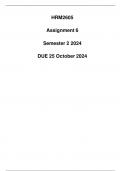HRM2605
Assignment 6
Semester 2 2024
DUE 25 October 2024
, QUESTION 1
Scenario Analysis
Godfrey Makobane, a plant manager in Cape Town, has observed significantly higher
absenteeism and turnover rates in his plant compared to a similar plant in Gauteng,
managed by Melvin Alers. Upon investigation with HR, a job satisfaction survey was
conducted, revealing low satisfaction levels across several categories. I analyzed the
survey findings, propose actionable HR improvements, and consider the implications if
the issues remain unaddressed.
1.1 Feedback and Interpretation of Survey Results
1.1.1 Analysis of Job Satisfaction Categories
Each category from the survey reveals specific insights into employee dissatisfaction,
likely contributing to absenteeism and turnover rates. Below is an analysis of each
category:
1. Job Itself (60% Dissatisfied)
Dissatisfaction with job roles often stems from monotonous tasks, lack of autonomy,
or lack of fulfillment. If employees do not find their work engaging or purposeful, their
motivation decreases, contributing to increased absenteeism and turnover
(Herzberg, 1959). In manufacturing environments, repetitiveness and limited
opportunities for creativity or decision -making can significantly impact satisfaction
levels.
2. Relationships with Co-Workers (51% Dissatisfied)
Interpersonal relationships are crucial to workplace morale. A dissatisfaction rate of
51% suggests potential issues with teamwork, conflict, or lack of support among
peers. Poor team dynamics can lead to isolation, impacting productivity and
engagement (Robbins & Judge, 2018). In light assembly work, collaborative tasks
are common, so strained relationships can disrupt efficiency and cohesion.




